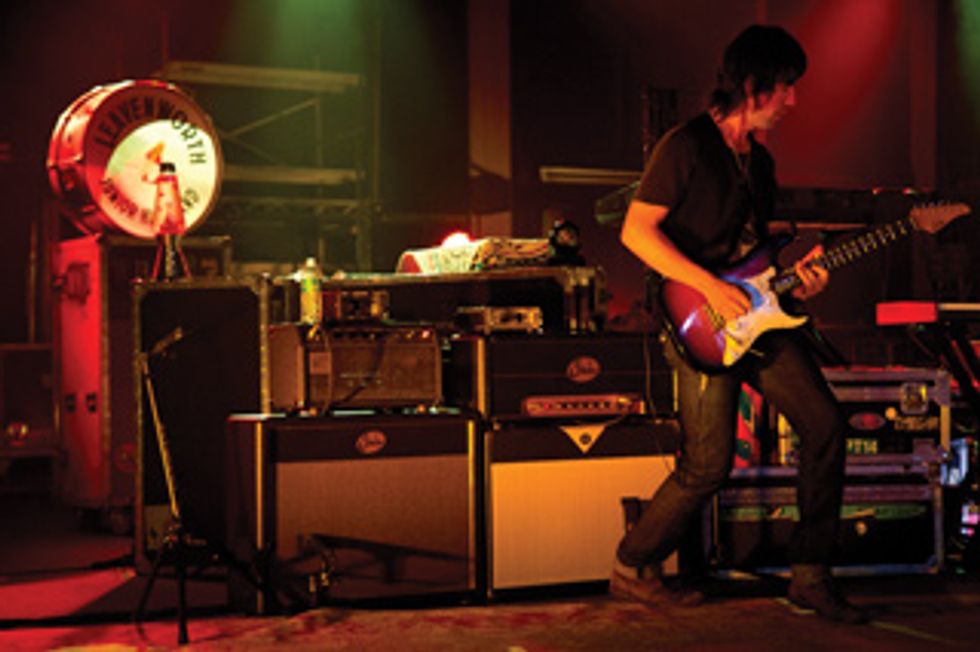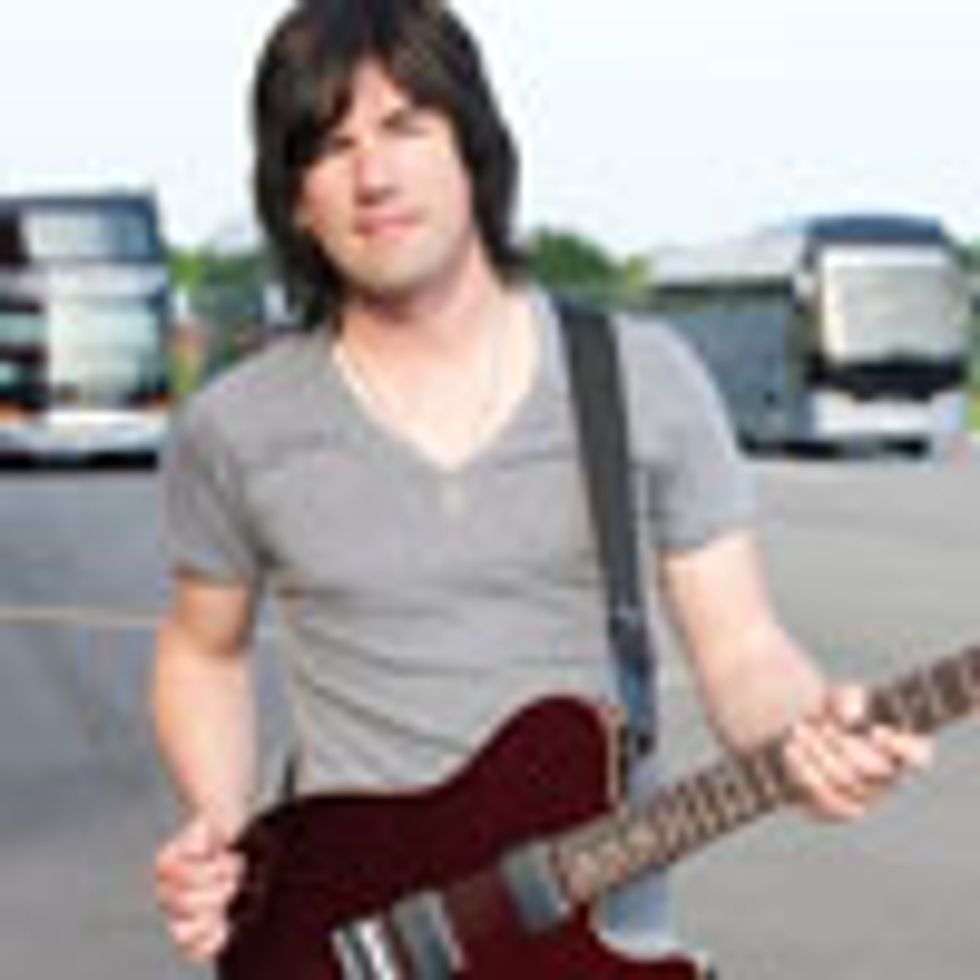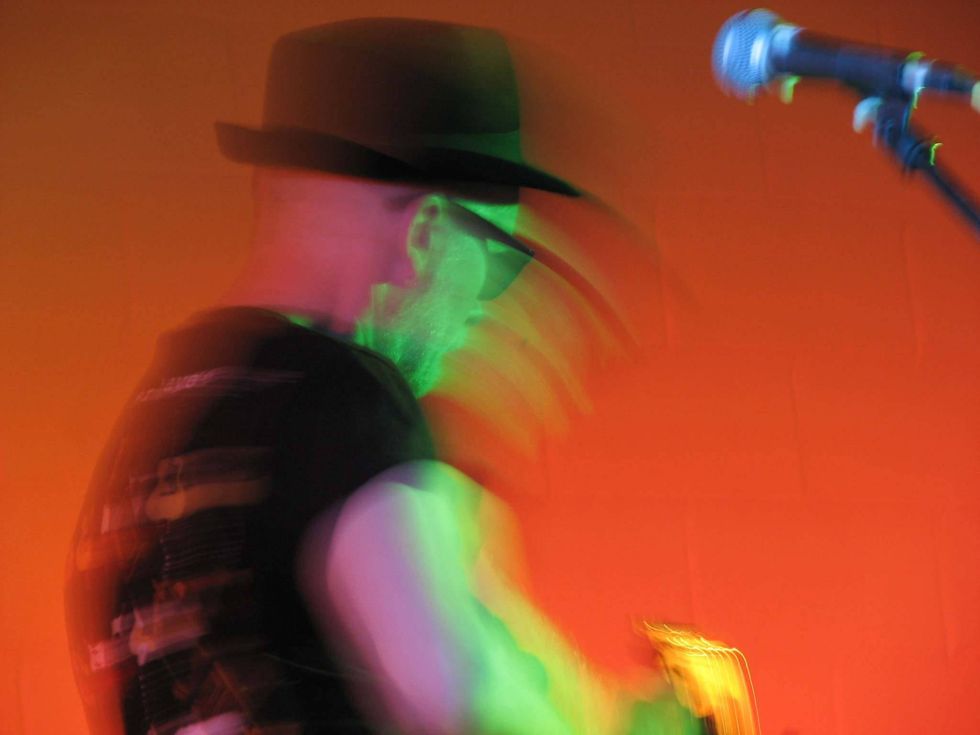
Depending on the gig, bigger isn’t always better when it comes to your rig. Shown here is Peter Thorn and his current “lean and mean” rig he’s using on tour with Melissa Etheridge: A Jim Kelly Reverb head matched with a Suhr 2x12 on the left that he A/Bs with the Suhr SL68 head with a Divided By 13 2x12 on the right. Photo by Joshua Smith
Welcome to my first installment of “Tone Tips.” I’m honored and excited to be a part of the fine publication that is Premier Guitar. For those who aren’t familiar with me, I’ve primarily made my living as a touring sideman for the last 15 years, playing with such artists as Chris Cornell, Don Henley, Melissa Etheridge, and others. My goal with this column is to pass on some real world, practical knowledge that I’ve learned while touring. Sometimes the focus will be on equipment, sometimes on playing and performing, and sometimes on how I operate mentally on a day-to-day basis while touring. This month, let’s discuss how to choose the right gear for a particular gig.
No Two Gigs Are the Same
It took me a while to realize that every
single gig I do is different—in every aspect.
The music is all certainly different, but in
many other ways, no two gigs are the same
because the dynamics of each tour varies.
Let’s take travel, for example. You might be
flying everywhere on some gigs, traveling
by tour bus on others, or even faced with
traveling in a 15-passenger van with an
attached trailer on another.
The number of band and crew members varies from gig to gig as well. You might have your own tech, share a tech with another member, or have no tech at all. All these and other variables need to be looked at carefully when choosing what gear you‘ll use for a particular gig. Let’s start with the audition...
Auditioning and Gear
You are always expected to bring your own
guitars, accessories, and pedalboard/effects,
but in my experience doing auditions, an
amp and cabinet will often be provided
for you. (You should, of course, always ask
beforehand.) The thinking is that providing
an amp will mean less setup and teardown
time between auditions, thereby facilitating
auditioning numerous guitarists. That said,
I have mixed feelings about using amps that
are provided at auditions.
Sure, using a provided rental amp means less stuff to carry to an audition and (arguably) less setup time, but you want to be as comfortable as possible when auditioning, and also put your best foot forward when it comes to your tones. I really try to make an impact at auditions, not only with my playing, but with my tones and attention to detail on specific sounds as well. For this reason, I always bring my own amp, though I will sometimes use a provided cabinet as long as it’s of good quality. On some other occasions, I’ll politely insist on using my entire rig. It will most likely take you less time to set up and get your tone dialed in using your own amp since you’re already familiar with its controls and features.
You also want to bring the appropriate amp and guitars for the audition. Hypothetically, let’s say you have an audition for Sheryl Crow’s band. I wouldn’t recommend using a pointy guitar with a Floyd Rose and EMGs through a Mesa Triple Rectifier amp! I’d bring a Tele, a Gretsch, or an SG, and for an amp, maybe an AC30, Twin Reverb, or possibly a tweed Bassman. Likewise, if it’s a metal band you are auditioning for, you should bring gear that suits the music. I remember auditioning 30 bassists for a straight-up rock band I was in 10 years ago, and I could tell right away when a musician walked in and opened his case if he was a candidate or not. When someone pulled out a 6-string bass with the strap real high, I knew immediately he wasn’t the guy. But when another guy came in looking like Billy Idol and pulled out a ’70s P bass, I knew we were getting somewhere.
Once You’ve Got the Gig …
The music you play is certainly a primary
factor in dictating what gear you choose for
a specific gig, but let’s talk about the other
factors to consider. Sometimes there will only
be one or two stage techs, and they have to
set up and tear down an entire stage full of
gear each night. Not only that, they have to
watch the band for onstage mishaps, handle
guitar changes, and more. In this type of
scenario when you don’t have your own dedicated
tech, I’d recommend bringing a small,
simple rig, and trying to be as self-sufficient
as possible. The crew will thank you, and if
something goes wrong with your rig, it’ll be
easier to troubleshoot yourself.
Another important consideration is the size of the band. I learned this the hard way. In one of my current gigs, there are two keyboard players, another guitarist, and sometimes a horn section. It’s a fairly large band, but I have my own tech on this gig, which allows me the luxury of using basically whatever I want. When I first started the gig, I brought in my big wet/dry/ wet rig, which consists of a 12-space rack, a Suhr PT-100 amp head, a mono 4x12 cabinet for the dry signal that gets panned center, and two 1x12 cabs that get hard panned with stereo effects in them. The rig requires three mics with one on each cab, and it’s an amazing sounding setup. But the other guitarist uses just a few pedals into a Peavey Classic 50 4x10 combo—one mic, mono in the house. Lo and behold, he was cutting through the mix much better than me! What I learned is that a bigger rig isn’t always better. In a guitar/bass/drums trio, the wet/dry/wet rig (or another stereo rig of some sort) is fantastic. But in a larger band situation, it’s easy to get lost in the mix, so I’d recommend a more focused, mono rig.
See you next month for more Tone Tips!
 Pete Thorn is an L.A.-based guitarist, currently touring with Melissa Etheridge. His solo album, Guitar Nerd, is available through iTunes or cdbaby.com. Read more about his career at peterthorn.com.
Pete Thorn is an L.A.-based guitarist, currently touring with Melissa Etheridge. His solo album, Guitar Nerd, is available through iTunes or cdbaby.com. Read more about his career at peterthorn.com.










![Rig Rundown: Russian Circles’ Mike Sullivan [2025]](https://www.premierguitar.com/media-library/youtube.jpg?id=62303631&width=1245&height=700&quality=70&coordinates=0%2C0%2C0%2C0)







